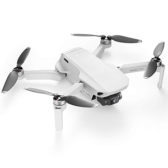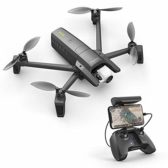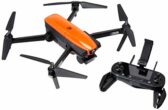The Best Drones for Traveling the World With in 2021
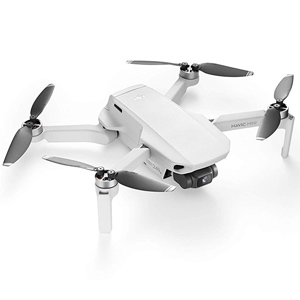
DJI Mavic Mini
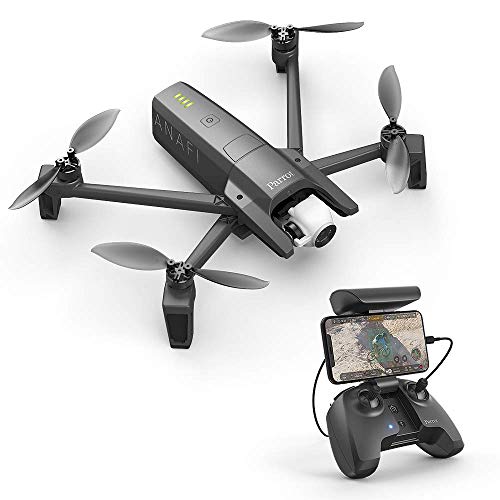
Parrot Anafi Base
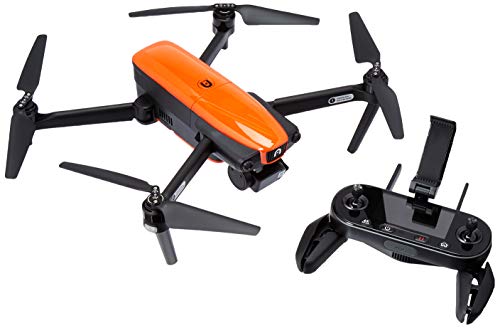
Autel Robotics EVO
If you haven’t used a drone to take your vacation photos yet, you’re certainly missing out on an incredible opportunity!
Drones give you the chance to shoot breathtaking cinematic footage and photos of your trip. Even a routine trip down to the beach can turn into a home movie worthy of an Oscar.
However, it all starts with choosing the right drone for the job. There are tons of options to choose from, so how do you pick?
Today, we’ll run you through the best travel drones you can buy, and a guide on what to look for.
The Best Travel Drones
We may receive compensation on qualifying purchases via our links. This does not change how we review items. For more information, please read our affiliate disclosure.
The Mavic Mini has replaced the hugely popular Spark model and will become one of the most popular drones of all time.

- Flight Time: ~28 minutes
- Charge Time: ~90 minutes
- Range: 3000m / 9842ft
- Remote Controller: WiFi 5.4GHz & 2.4Ghz (included in the set)
- Camera: 3-axis gimbal 2K Camera with 12MP
- Live Video Transmission Range: 2500m / 8200ft
- Weight: 249g / 8.78oz
- Working Temperature: 0°C ~ 40°C
- Rated for indoor and outdoor use
The Mavic Mini might just be one of the smallest drones in DJI’s arsenal. It’s much smaller than even a Mavic Air, comfortably fitting in the palm of your hand.
There’s no doubt that DJI wanted to create an extremely portable travel drone with this one. Size and weight wise, they definitely succeeded. The Mavic Mini registers at just 249g, narrowly avoiding FAA requirements.
But the problem with tiny drones is that they also lack quite a bit of the capability of bigger ones. Fortunately, the Mavic Mini manages to overcome this hurdle magically.
Sure, the Mavic Mini lacks all the fancy and powerful features of its older brothers. But compared to similarly-sized drones, they pale in comparison to what the Mini is capable of.
The Mavic Mini sports a tiny but powerful camera that’s capable of shooting 12-megapixel resolution stills and 2.7K videos. It’s also mounted on a 3-axis gimbal, giving it incredible footage stability.
Indeed, the photo and video quality will make you forget that this is actually a beginner drone. That it can be brought along and used by professionals as well is a testament to how versatile the Mavic Mini is.
Being a starter drone, it has all the features a newbie pilot will appreciate. A revamped DJI Fly app allows amateurs to jump right in with an easy to understand user interface. It also has QuickShot modes, pre-programmed flight paths that make it easy to make Hollywood-level shots with the push of a button.
You also get an incredibly long 30 minute flight time with the Mavic Mini. That’s really great for amateur pilots of uninterrupted practice time.
Overall, DJI has redefined the beginner drone with the Mavic Mini. Travel enthusiasts, however, will see it more as a powerful yet extremely compact travel drone that might be a total game-changer.
+ Pros
- Cons
GPS, 4K video and a staggering 21 MP camera allows for some of the most beautiful drone shots imaginable.

- Flight Time: ~25 minutes
- Charge Time: ~240 minutes
- Range: 4000m / 2.5mi
- Remote Controller: WiFi 5.4GHz & 2.4Ghz (included in the set)
- Camera: 180° adjustable f/2.4 ASPH lens 4K Camera with 21MP
- Live Video Transmission Range: 4000m / 2.5mi
- Weight: 320g / 11.28oz
- Working Temperature: -10°C to 40°C
- Rated for indoor and outdoor use
When you’re looking for a compact yet powerful travel drone, the Parrot Anafi just might fit the bill. At only 320g and folding down to a size that can easily be held with one hand, the drone certainly has a small footprint in your travel bag.
Let’s look at the basics first. The Anafi is capable of up to 25 minutes of flight time, a generous length as far as drones go. The performance is excellent as well, with ultra-responsive control, thanks in part to the easy to handle Skycontroller 3 remote controller and FreeFlight 6 app.
Further adding to the Anafi’s flight prowess is its stable wind resistance and super-quiet operation, great for ensuring you don’t disturb anyone near you.
For those traveling alone, the autonomous flight modes are a real treat. Follow Me and Camerman mode will be your best friend in these situations; the Anafi does a swell job in producing incredible, unassisted shots.
The camera is, in a word, incredible. It can shoot at a remarkable 21 megapixels for stills and 4K resolution for videos. Together with a 1 / 2.4 inch CMOS sensor and a 3-axis, 180-tilt gimbal, rich and smooth photo/video is more or less assured. Low light performance is not bad, with a maximum ISO of 3,200.
Compact, robust, and lightweight pretty much sums up the high points of the Parrot Anafi. It’s a travel drone that’s flexible enough to fit most users, from casual to pro.
+ Pros
- Cons
A 4K drone with a 12MP camera that folds up for handy portability. It’s water-resistant, too!

- Flight Time: ~30 minutes
- Charge Time: ~210 minutes
- Range: 7050m / 4.4 miles
- Remote Controller: WiFi 2.4GHz (included in the set)
- Camera: 3-axis gimbal 4K 60fps camera with 12MP
- Live Video Transmission Range: 7000m / 4.3 miles
- Weight: 863g / 1.9lbs
- Carry Capacity: N/A
- Working Temperature: 0°C ~ 40°C
- Rated for outdoor use
With a size and power rivaling that of the Mavic Pro, Autel Robotic’s EVO is a feature-rich drone that costs much less than the DJI flagship.
With a foldable design and weighing in at only 370g, the EVO is also portable, as well. Even the included remote controller can be folded into an easy-to-carry shape.
The EVO’s power lies in its imaging capabilities. Its camera is capable of up to 12 megapixels for still photos, and 4K UHD for video. For further enhancement, it also has an Ambarella H2 Image Processor.
What this all means in practice is that the EVO produces images and footage with fantastic definition and dynamic range. Jittery video is also eliminated thanks to the 3-axis stabilized gimbal.
The EVO also has a buffet of flight modes, giving plenty of flexibility for pros and newbies alike. Things like GPS Return, Failsafe, and One-Touch Action Buttons make moving around and taking photos easy.
Plus, EVO also has advanced intelligent flight modes, made possible via its Dynamic Track facial recognition software. Use it to make the drone follow you or any object accurately, as long as there’s sufficient light. Everything is easily accessed via the Autel Explorer App, designed solely with the EVO in mind.
As far as powerful compact travel drones go, the Autel Robotics EVO is undoubtedly at the top. DJI might be dominating, but Autel has the potential to give them a run for their money.
+ Pros
- Cons
Arguably the best drone around with these specs. A true competitor to the DJI Spark in this price bracket.
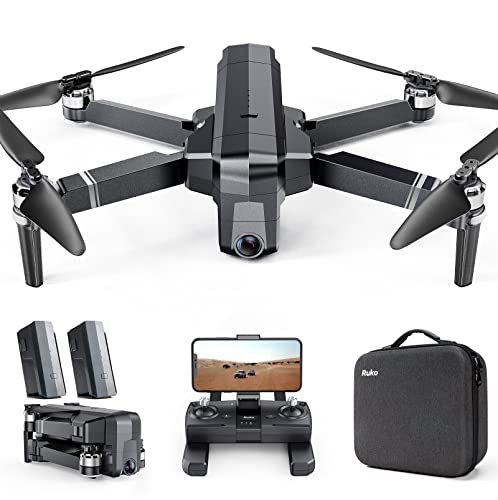
- Flight Time: ~28 minutes
- Charge Time: ~210 minutes
- Range: 1219m / 4000ft
- Remote Controller: WiFi 5GHz (included in the set)
- Camera: 90°Adjustable 4K Camera with 13MP
- Live Video Transmission Range: 500m / 1640.4ft
- Weight: 520 g / 18.34 oz
- Rated for indoor and outdoor use
The Ruko F11 Pro is for you if you’re looking for a travel drone with very long flight time. Now, the beautiful thing about it is that you get that in a compact, foldable drone at a relatively accessible price.
The drone is capable of 30 minutes of flight time, putting it in the same range as your typical DJI model. The F11 Pro comes with an extra battery, though, giving it a whopping 60 minutes of combined flight time.
For backpackers, hikers and those on extended travel without access to electricity, this is a godsend. The fact that it compresses to the size of a smartphone when not in use is just a bonus.
The other features of the Ruko F11 Pro are nothing less than spectacular, as well. The 4K resolution camera will be appreciated by pros and amateur videographers alike. Beginner pilots will like flight features like Headless Mode and GPS Hold.
You also get intelligent flight modes like Follow Me and Orbit Mode for photographers who like to fly solo.
Overall, the Ruko F11 Pro is an excellent addition to the already substantial drone market. Where it stands out, though, is the combination of advanced features, long flight time, and affordable price.
+ Pros
- Cons
If you’re looking for a low-budget travel drone, the AEE Selfly might be worth considering.
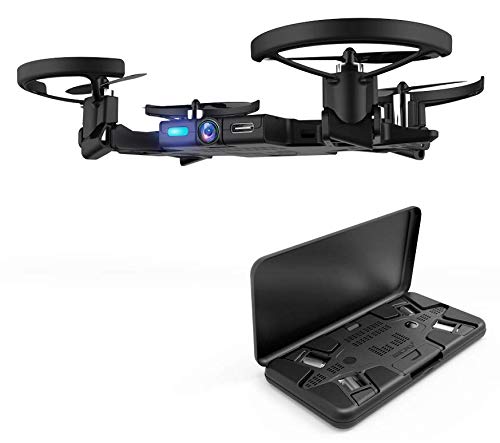
- Flight Time: 6 minutes
- Weight: 68g
- Camera: 13 megapixels with 720p HD video resolution
The AEE Selfly is probably the lightest and thinnest drone we’ve ever come across. It just weighs a paltry 68g; your smartphone is probably heavier! When not in use, it shrinks down to a 10mm wide frame with its own pocket case, which snaps conveniently to the back of your smartphone.
So, really, this drone is the ultimate in portability. No bulky bags needed; you don’t even need to pack it in your luggage. A few extra millimeters of pocket space is all that it will take.
It’s small, but does it get the job done?
First, the photo quality, because any selfie drone worth its salt needs to take decent photos at least. With a 13-megapixel camera, fortunately, the Selfly satisfies this requirement. The pictures it took are superb, crisp, and defined at a decent enough resolution.
The video wasn’t too bad either, and the ability to shoot at 60 fps opens a few creative doors.
Flying the Selfly isn’t too hard, either. It’s solely controlled through your smartphone via an app – which is the entire reason it’s clipped to the back of it. Controls are intuitive, and you can operate the drone entirely without relying on manual flight.
Flight performance of the Selfly is smooth with no apparent hiccups. You can make it takeoff and land with the press of a button, and it will also do this automatically when the battery levels get too low. GPS fencing also allows you to limit the height your drone can fly, a great safety feature.
Autonomous flight is a necessary feature of a selfie drone, and Selfly does this pretty well. The drone uses facial recognition to follow you around and take photos.
The Selfly has two drawbacks, though. First is the low battery life. At just 6 minutes, it really is just enough to do some quick selfies, which, to be fair, is what it’s really meant to be.
Next is that it’s not stable in strong winds. This is an instance where the very lightweight of this drone works against it. This makes the Selfly less suitable for windy outdoor locations, and more for city sightseeing.
Despite this, the AEE Selfly is still a fantastic pocket drone. With the smallest space footprint possible in a drone, this is a great travel companion for more casual trips.
+ Pros
- Cons
Though not named after Harry Potter’s house elf, the Dobby is a cute little assistant for anyone on their travels.
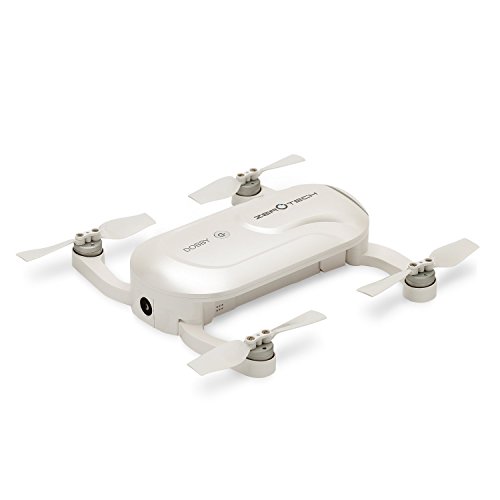
- Flight Time: 9 minutes
- Weight: 199g
- Camera: 13 megapixels with 1080p HD video resolution
The Zerotech Dobby Smart Drone is a pocket-sized selfie drone that’s no larger than your average smartphone. Indeed, this drone is designed to be whipped out of your pocket, deployed to take photos, then stowed back again. Just like that.
At a mere 199g, this is a drone that’s built for portability. This makes the Dobby super convenient when you’re on the road.
You can fly and control the drone straight from your smartphone, so there’s no need for a separate controller. It’s intuitive to operate as well and even allows for gesture controls – great for beginners.
Since this is a selfie drone, the camera is where we’re going to start. Photography is clearly one of its strong suits, thanks to its 13-megapixel camera and 1/2.2 inch CMOS sensor. That’s more than enough to take amazingly vibrant and crisp photos as such as small size.
It can also take videos at 1080p HD resolution, which is also quite decent. Although photo quality is definitely superior to video.
What’s more, the Dobby is one of those rare compact drones that has a 3-axis gimbal installed. This means your photos and videos will be stable even with excessive shaking. Which makes sense in a small drone; since they’re lighter, they’re more prone to movement.
Another standout feature of the Dobby is its facial recognition technology. Called FOLLOW SNAP 2.0, you can use it for autonomous flight modes like Follow Me.
The Dobby also has exceptional flight performance. It has several automatic and pre-set flight modes to help the newbie out. Which is excellent, since manual control can feel a little jumpy for some pros, if only because there’s no physical joystick involved.
It has a GPS onboard which opens up a neat little trick: the ability of the Dobby to launch and land on your palm. Launching is easy, but landing? But thanks to GPS, the drone will know precisely where you are. Then, it’s capable of detecting your hand, at which it will switch off its rotors for a safe landing. Cool eh?
The big drawback of the Dobby, however, is the battery life. For the price, it’s only capable of a maximum of 9 minutes of flight time – nearly not as much as others in its price tier.
+ Pros
- Cons
Are Drones Suitable To Travel With?
The answer, at least for consumer drones, is a definite yes. Drones have evolved from clunky aerial machines to compact devices, sometimes no larger than your mobile phone.
This added portability means that it’s easier than ever to take your drone anywhere with you.
However, being able to bring a drone along doesn’t mean you can use them all of the time. As drones became widespread, authorities started to regulate their use. This is due to several reasons that mostly involve invading private and restricted space.
If you want to shoot with a drone in a foreign country or area, be sure it’s allowed. You don’t want to go through the trouble of packing one, only to find out you can’t use it at all.
Bringing a drone along also adds additional responsibilities to your trip. You need the extra luggage space for the drone itself and the accessories. You also have maintenance and upkeep to attend to, not to mention the constant worry that your precious drone might get damaged at any time.
But if you accept those risks and responsibilities, you’ll be rewarded with amazing shots of your trip, from unique perspectives that were never possible just a few years ago.
You just need patience and lots of preparation to pull it off.
How to Choose The Right Travel Drone For You
Choosing a travel drone is no different from any of your other travel gear and equipment. All of it really depends on where you travel to, and how.
What a backpacker will buy is vastly different from what a casual vacation goer will. If you hike a lot, then you’ll have specialized needs that a yachtsman will never understand.
So start with your travel style, then align that with the drone you plan to buy.
To help you out, here are a few travel styles we came up with. See if you resonate with one or more of these:
Casual travelers
These are people who are your typical tourists. They just want to capture their vacation memories and post it straight to social media. A drone is there to help them add some oomph and pizzazz to their photos.
If this describes you, then we recommend going for a mid-priced travel drone that’s flexible enough for different locations. You want something very compact, so you can easily set it up and fly it in a moment’s notice. Camera-wise, getting one that shoots video at a decent quality (1080p HD) is usually enough.
Professional travel vlogger
For travel vloggers or professionals, image quality is everything. They want to promote the beauty of the places they visit, so they want to capture it in the best light possible.
With this, getting a drone with an exceptional camera is crucial, something that’s at least 4K video resolution or 20+ megapixels for stills. It’s usually acceptable to sacrifice a little bit of portability just to get the best photo/video possible, but keep in mind it’s still important to get as many shots per drone run.
Other features to get include intelligent flight modes to help vloggers create professional-looking, cinematic shots.
Backpacker or hiker
Mostly, a backpacker and a hiker have more or less the same concerns – packing efficiently. So right off the bat, they need the most compact and portable drone they can get.
Backpackers and hikers might also potentially travel to areas without electricity. This makes having drones with a long battery life essential. At the very least, they should invest in a few spare batteries to maximize their drone runs throughout the day.
Lone traveler
If you’re the person who loves traveling alone, there’s always one pressing concern in mind – who’ll take your photos? It’s ever tiring to ask strangers to do it for you, and sometimes it’s not even possible.
Luckily, drones have managed to solve this problem. For the solo traveler, having a drone with autonomous flight features is absolutely required.
The basic is Follow Me, which makes the drone act like a “buddy” to take their photos. Make sure you get one that can track you accurately. Obstacle avoidance is also a bonus, especially if you plan to shoot in dense, forested locations.
What Features Should You Look For?
In a way, since they are designed to fly outdoors, almost all consumer drones are technically travel drones. Of course, some are much more suitable for it than others.
While the travel drone that you pick will ultimately boil down to your purpose, there are some commonalities. Here are some of the factors that you need to consider:
Portability
This is the most critical concern for a travel drone. A powerful fully decked out drone is useless if you can’t take it with you. If it needs its own full-sized luggage, chances are that it’s too large for travel needs.
The portability of a drone is a factor of two things: its weight and size.
Size is arguably a more significant influence on portability. Smaller drones are easier to pack in a standard backpack or even a purse, making them quite convenient. This allows you to bring them anywhere you want, without the need for a separate, bulky travel bag (although we highly recommend still getting one; check out a later section of our recommendations.)
But since drones are sophisticated devices, it’s hard to reduce their size without sacrificing some of their functionality.
That’s why the trend right now is to make them foldable. Through some engineering magic, these drones are compressed into a smaller size when not in use for more accessible storage and transport. But come flight time, they unfold Transformers-style into their full size, ready for flight.
Some of the most powerful consumer drones nowadays are foldable, so this is definitely an excellent feature to look into.
Of course, size isn’t the only consideration. A small drone isn’t too portable if it’s heavier than a rock; it’ll tire you out carrying it pretty quickly. That’s why it’s also best to look for drones made with lightweight material.
Plastics are the cheapest and most lightweight material but are not that sturdy. Carbon fiber offers a good balance between cost, weight, and durability. Professional drones use incredibly lightweight and durable materials but are the most expensive.
Another benefit of being lightweight is that it’s less of a drain to the drone’s battery. This is because the rotors don’t have to work harder just to carry all that extra weight; hence, they don’t consume battery power as much.
Of course, portability is a matter of personal preference. What’s bulky for some might be the perfect travel size for you.
If you do a lot of backpacking, packing light is essential. Hence the most compact drone should be your choice. However, if you mostly travel cross country via your own car, you can invest in a bulkier drone to get access to better features.
Battery Life
For a travel drone, battery life is an important consideration. The longer it is, the more your drone can stay airborne, and the more pictures you can take. Flight time is actually dependent on your drone’s battery life more than any other factor.
Battery life is vital for any traveler, but it is much more crucial if you travel to an area without any power source. These include hikers or mountain climbers going off the grid, or backpackers going into remote places in the world.
A bigger battery capacity usually features in more expensive drones. DJI, in particular, is well known for having drones that have long battery and flight times, at around 30 minutes or more. Mid-priced drones in the $500+ range will have flight times at the 15 – 20 minutes range. The cheapest drones will have 10 minutes or less.
Now, you might say, why invest in a more expensive drone when you can just buy more batteries? Actually, having lots of spare batteries is a sound strategy that we recommend any travel drone owner have.
However, you still have to land the drone to swap the batteries. This takes time and ruins the momentum, especially if you’re in the middle of a really great run. Having a long battery life will give you a much more uninterrupted fun time with your drone.
Durability
My personal rule with anything portable is that they also need to be durable. This applies more so with something as expensive as a drone.
Your drone needs to be durable and rugged, regardless if it’s on the air or in your bag. You never know what kind of conditions you’ll encounter while traveling, so it must survive a few beatings and unavoidable crashes.
Durability is especially important if you’re still developing your piloting skills. But even experts can benefit from a sturdy drone. This is especially crucial if you continuously attempt complex flight paths and stunts, or if you fly your drone in a dense area with lots of obstacles, such as a forest.
One of the primary factors of durability is the drone’s frame. It should be lightweight but also durable at the same time. It must be able to protect the delicate internal components of the drone, such as the camera and the motor.
Some drones, especially those aimed at beginners, will also have prop guards to protect the sensitive rotors in case of a crash. These are indispensable when you’re starting out. A lot of drones will also have padding installed in critical areas, such as the frame and motors, to better cushion the blow of a crash or bump.
Durability is a crucial factor, no matter if you’re a pro or a casual travel drone user. A broken drone is a surefire way to ruin an otherwise great trip. So make sure you get the sturdiest drone your budget will allow. It will save you lots of time, money, and disappointment in repairs and replacements.
Flight Stability
A good travel drone should be able to maintain stability while in flight, despite adverse conditions.
The biggest threat to this is strong winds. Your drone needs to be able to withstand this and still maintain position and altitude. Heavier drones are better at this than lighter ones, since they have the mass to resist winds.
However, it doesn’t mean you get the heaviest drone you find, because then it’ll be a significant battery drain. It’s a delicate balance between weight, stability, and flight performance.
Modern drones also now have different technologies to help with stability. These include GPS, optical cameras, and infrared sensors, with more being invented. Most of these are automatic, allowing the drone to mostly correct itself.
Waterproof
If you’re continually taking aerial shots near the water, or want the freedom to take your drone out whatever the weather condition is, consider a waterproof drone.
When you think about it, being waterproof is actually a massive asset for a drone. The constant threat of rain and crashing into a lake is all too real, so you try to veer away from these conditions. It’s pretty limiting as a drone pilot if you ask me.
Waterproof drones give you a bit of that freedom back.
It’s somewhat surprising, then that not a lot of drones in the market are waterproof. The feature is actually pretty rare, except in models made explicitly for that purpose. Not even top drone makers DJI has it in any of their consumer lineups. So if you’re thinking of getting one, you’ll have to go out of your way.
With that being said, there are many levels of “waterproof-ness” in various drones. Some can only handle a small splash, while others are capable of going underwater.
Think carefully where you plan on using your drone, and purchase accordingly.
Follow Me Mode
For travelers who love exploring the world alone, this feature is practically a must-have.
Follow Mode is a feature in drones that allows it to follow you around autonomously. It does this via virtually tracking the GPS transmitter in your drone remote controller or smartphone. This will enable you to take photos of yourself without worrying about controlling the drone.
Using GPS tracking is an inexpensive yet accurate way of having the drone follow you autonomously. For most casual travelers, this is more than enough.
Alternatively, some advanced drones can also track you around visually, much like how a person would. The problem with this is that there needs to be a high amount of contrast between you and the background for the drone to track you accurately. This makes it unsuitable in low light conditions.
Visual tracking, however, is much more flexible. You can have it follow any moving object, not just you.
Camera Quality
Most people bring travel drones with them because they want to take terrific aerial photos of the places they visit. So camera quality is a critical factor in this case.
For most casual travelers, however, a mid-range camera is more than enough. This falls in the 1080p to 2K range or around 5 to 12 megapixels. You can also go for lower-end 4K cameras if the budget allows. These will net you photos that look great on social media or when viewed from your phone.
But if you’re someone like a high-end vlogger, you would want the best camera quality you can find – something like 4K resolution. You also want more leeway during editing, so you can bring out the best from your photos.
If you’re seriously considering the best camera quality, check out our reviews on the best photography and best videography drones in the market.
Safety Features
When you’re out in the world, lots of unexpected dangerous things can happen to your drone or to other people. That’s why your drone must have safety features installed. Let’s go over one of the essential ones you should have
One of them is GPS Return. This makes the drone return to its takeoff point automatically. It usually does this when its battery level reaches a critical level, so it has time to land safely. Some drones also return to its origin point when it loses GPS signal, or if it wanders off too far from the pilot.
More advanced safety features include a collision detection system. With it, your drone will be able to know if an obstacle, such as a wall, is in front of it. It will then automatically stop and hover in place, or it will avoid it and continue moving. This vital while your drone is flying in autonomous mode.

